| Setting the Frame Counter |
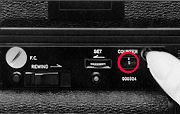
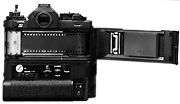
1. Press the frame counter reset button before loading the film. This will return the frame counter to "S"
2. Open the camera back and load the film. Insert the film leader into one of the slots in the takeup spool and, using the camera's film advance lever, advance one frame of film. Make sure the sprocket teeth engage the film perforations.
3. Then close the camera back and take two blank shots. The frame counter will read "36."
4. When loading a roll of film with fewer exposures than 36, such as 24 or 12, first follow the steps above. Then push in and turn the counter setting wheel in the direction of the arrow until "24" or "12," for example, is aligned with the index.
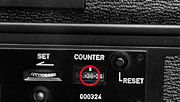
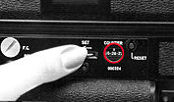
Notes
1. The counter setting wheel will turn only in the direction of the arrow. If you turn past the number you intend to set, press the frame counter reset button and start over from "S."
2. Do not set the frame counter to a number larger than the number of frames of the film. If the counter is set to a larger number and the film ends before the frame counter reaches "O,'' the film perforations may be torn.
3. The frame counter of the motor drive is a reverse-counting type while that of the camera is an additive type. Consequently, their readings will not be the same.
| Shooting |
PART I: Shutter-Priority
AE Photography
One of the primary functions of the AE Motor Drive FN is to convert the New F-1 to
shutter-priority automatic exposure (AE). This AE mode is possible with an FD lens.
Note: In general, centerweighted average metering
is recommended for AE photography.
- 1. Turn the aperture ring of the lens, while pressing the AE lock pin, until the "A" mark is aligned with the distance index.
- 2. Set the desired film driving speed by pulling up and turning the mode selector until "S", "L" or "H" is aligned with the index.

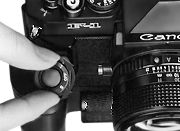
At the "S" position, a single exposure is made when you press any of the
three shutter buttons, and the film is automatically advanced when you remove your
finger from the shutter button. At the "L" and "H" positions,
sequential photography is performed as long as you press any of the shutter buttons.
The film driving speeds at the "L" and "H" positions vary with
the power source used. Refer to the following table:
|
Maximum Shooting Speeds: |
|||
| Power Source* / Mode Selector |
S |
L |
H |
| Battery Pack FN |
1 Frame |
3.5 fps |
5 fps |
| Ni-Cd Pack FN |
1 Frame |
3 fps |
4.5 fps |
| High Power Ni-Cd Pack FN |
1 Frame |
3.5 fps |
5 fps |
* Using new carbon-zinc batteries or a fully-charged Ni-Cd pack.
- 3. Set the New
F- 1 's shutter dial to the desired shutter speed. The shooting mode determines which
speeds can be used:
Warning: The "B,"Flash Symbol" and "A" settings on the dial cannot be used with shutter-priority AE.Usable Shutter Speed Range
Mode Selector Shutter Speed Range
Battery Pack FN 1/2000 sec - 1/60 sec
Ni-Cd Pack FN 1/2000 sec - 8 sec (Except "B")
High Power Ni-Cd Pack FN 1/2000 sec - 8 sec (Except "B")
- 4. Look into the viewfinder and lightly press one of the shutter buttons to get a meter reading. The meter needle will point to the f/stop the camera has selected automatically. For correct exposure, the meter needle should not be in either the overor underexposure warning zone. If it is in either zone, turn the shutter dial until the meter needle moves out of the warning zone.
- 5. Press the shutter release button all the way down to take the picture.
Notes:
1.
If there are no batteries in the motor drive (Battery Pack FN) or if loaded and their
voltage drops below operating level (Battery Pack FN or either Ni-Cd Pack), shutter-priority
AE photography is impossible. In this case, setting the lens' aperture ring to the
"A" mark will lock all shutter buttons, thus preventing shutter release.
To use the camera manually, simply remove the lens' aperture ring from the "A"
mark and set an aperture in the usual manner
2. Shutter-priority AE is possible even if the mode selector is OFF as long as the
lens' aperture ring is on the "A" mark. In this case, the film will not
be advanced automatically and the shutter must be released with the camera's shutter
button or the motor drive's vertical-position shutter button.
3. When the AE Finder FN is used in conjunction with the camera and motor drive,
continuous shooting is possible in the stopped-down AE mode. For correct exposure
with an FD lens, set an aperture smaller than f/2.8.
PART II: Manual Override
The New Canon F-1 functions as a manual exposure camera when the lens' aperture ring
is moved from the "A" mark. In this case, simply determine the correct
exposure in the usual manner by setting both shutter speed and aperture, matching
the meter and aperture needles in the viewfinder For further details, refer to the
instruction book of the camera.
Note: Use the shutter button on
the camera when shooting with the shutter dial on "B." If either of the
motor drive's shutter buttons is pressed, the shutter speed will switch automatically
to 1/1000 second.
PART III: Mechanical Operation
When the battery is removed from the camera, the New F-1 switches to mechanical shutter
control. In this case, only single-frame photography is possible even if the mode
selector on the motor drive is set to "L" or "H." Only the shutter
button on the camera can be used to release the shutter. The mechanically controlled
shutter speeds are 1/2000 to 1/125 sec., "![]() " (1/90 sec.) and "B." For further
details, please refer to the instruction book of the camera.
" (1/90 sec.) and "B." For further
details, please refer to the instruction book of the camera.
Two shutter buttons are provided on the motor drive for maximum ease of handling.
For horizontal shots, use the shutter button on top of the grip. Use the shutter
button on the side of the Battery Pack FN or Ni-Cd Pack for vertical shots. Of course,
the camera's shutter button can also be used.
| Next |
Specifications | Main Referrence Map (Nomenclature) | Loading the Batteries (Battery Pack FN) | Checking the Batteries (Battery Pack FN) | Mounting onto the New Canon F-1 | Setting the Frame Counter | Shooting Modes | Shutter Release | Rewinding the Film | Remote Control | Multiple Exposures | Accessories | Canon Motor Drive System Chart (PDF 236k)
| Back | To Main Index Page of Canon New F-1 WebSite
Its Concept, Its System
Metering Options, Viewfinders, Exposures Control, Reliability Issues,
Shutter Mechanism; Motor Drives/Winder, Data Film
backs,
Flash photography, Focusing Screens, Macro/Close-up,
Remote photography.
Canon FD & FDn Lenses.
| Message Board |
for your Canon F-1(n)
SLR camera(s)
| Message Board |
for your Canon optics in a shared environment
| Message Board |
Specifically for Dispose or Looking for Canon Photographic equipment
Main Reference/Layout Map for body: HTML | PDF (471k)
Specifications: HTML | PDF (58k)
Instruction Manual: Canon New F-1 Camera | Motor Drive FN | Canon High Speed Motor Drive Camera |
Home - Photography in Malaysia |
Copyright © 2000. leofoo ®. MIR Web Development Team.
Credit: Mr Richard Yeow, General Manager of camera and video division, Canon Marketing, Malaysia and Tony Kano, for being so supportive and granting permission to use some of the original content of Canon; Mr Philip Chong for patching some mistakes made earlier in this site. Made with a PowerMac, Broadcating with a RedHat Linux Server.